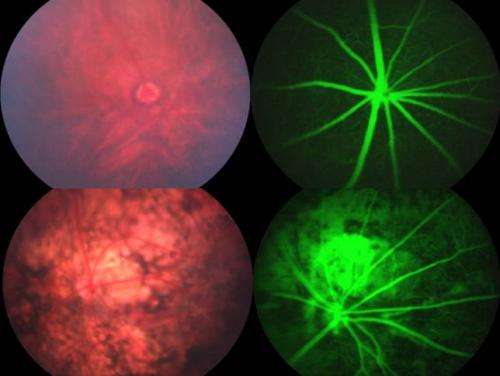New gene linked to blindness and Parkinson's disease

The retinal pigment epithelium (RPE) is a tissue, which lines the back of the eye. Aging, environmental (toxic) insults and genetic predispositions contribute to the death of RPE cells in diseases, such as age-related macular degeneration (AMD) and retinitis pigmentosa (RP), that ultimately lead to severe visual impairments or blindness.
The RPE also produces L-Dopa, an intermediate chemical compound required for the production of a chemical substance, called dopamine, which is crucial for the communication of certain specialized cells of the brain, called the dopaminergic neurons. When these neurons begin to die widely, because of aging and genetic predispositions, patients develop Parkinson's disease.
The findings, published online October 24 in The Journal of Biological Chemistry and supported by grants from the National Institutes of Health, provide a tantalizing genetic link between a multifunctional protein, called Ranbp2, and death (degeneration) of the RPE and Parkinson's disease.
The team led by Dr. Paulo A Ferreira laboratory at Duke University Medical Center, Durham, North Carolina, found that loss of Ranbp2 functions in the RPE of mice led to RPE degeneration with features that resemble a severe form of AMD, wet AMD, which is characterized by abnormal blood vessels and bleeding in the back of the eye.
They also pinpointed a selective Ranbp2 activity, which controls the flow of some proteins required for the communication between compartments of cells and that when impaired it suffices to trigger the progressive death of the RPE. Like in wet AMD, such deregulation of Ranbp2 sufficed to promote severe damage to neighboring blood vessels and bleeding.
Another surprising discovery was that a subset of mice without Ranbp2 functions in the RPE developed robust Parkinsonism tremors. This outcome results likely from the unexpected loss of Ranbp2 functions in selective neurons of brain regions which are in charge of controlling voluntary motor activity, an issue the authors are currently investigating.
These are promising findings, because they support that Parkinsonism and RPE death (degeneration) share multifunctional players and they open venues toward the development of novel therapeutic strategies to prevent or slow aging-related disorders, such as AMD and Parkinson's diseases.
More information: Patil, H et al, (2014) J. Biol. Chem. 289 (43) 29767-29789. www.jbc.org/content/289/43/29767
















